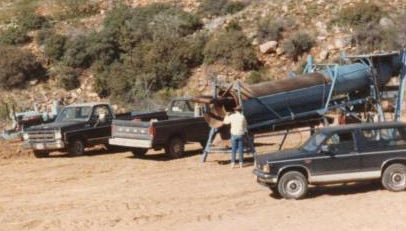The Weaver Mining district in Yavapai County has a well-known history of placer gold production.
Composed of old granite intrusives through schist, Rich Hill — between the deeply eroded canyons at Antelope Creek on the west and Weaver Creek on the east — is known as the richest placer deposit yet discovered in Arizona. Formed on the top of a mesa by the erosion of granite caused by weathering and decomposition, a significant placer gold deposit was revealed from below surface quartz veins and quartz stringers.
Abraham Harlow Peeples and a mining party under the guidance of Pauline Weaver sought out gold in Central Arizona. When the Weaver party tracked a missing burro to the top of a small mesa, loose nuggets amounting to 200 ounces of gold were discovered. The mountain top was eventually aptly christened Rich Hill, after producing over $100,000 in gold nuggets in the first month.
The estimated gold recovery at the site since has been over 110,000 ounces and is notable for its coarse, heavy qualities.
It is said that Jack Swilling, also a member of the Weaver party, accumulated his fortune at the site. Swilling went on to become heavily involved in irrigation in the Salt River Valley and farming in the area that is now Phoenix.
Between 1863 and 1899 Rich Hill and nearby placer discoveries along Weaver and Antelope creeks is credited with $3 million in gold production from gold bearing veins below the surface detrital iron-stained gravels and sands.
Weaver, also known as Weaverville or Rich Hill, is located in about 10 miles east of Congress Junction in the Weaver Mining district. Originally a tent city named after Pauline Weaver at the base of Rich Hill, it eventually became a place of greater province with rock and wood structures. The town had the reputation for being wild and rowdy.
Michael Goldwater, grandfather of late senator Barry Goldwater, operated a store at Weaver.
Outlaws frequented its establishments and Indian incursions were common. One such raid around 1863 resulted in the theft of burros, guns and clothing from a group of Mexicans who left the victims naked.
Several factors led to Weaver’s demise. Most important was diminishing gold discoveries. Daily murders also made living there challenging.
One of the final incidents involved the criminal death of William Segna, a local saloon owner in 1898.
A small cemetery with some ruins is all that remains of Weaver, a settlement that was eventually augmented into the nearby town of Octave, about two miles away.
Two small mills consisting of a steam boiler, crusher, two steam stamps, apron plates, cyanidation and table were built around Rich Hill in 1896 and 1933 were supplied by water from Antelope Creek and nearby wells. However neither processed more than several hundred tons of ore.
Early twentieth century mining involved dry-washers and wet-rockers to recover small amounts of gold. These mining operations amounted to operators barely making a living on the 140 acre property consisting of seven claims.
Hardrock mining in the 1930s around Rich Hill included the Eulick, Mamie, Mildred, Mountainside and Sloan Mines.
None proved very profitable, with quartz veins averaging 0.5 ounces of gold per ton. Consolidated Mining & Development Co. was involved in the development, including an incline shaft at 150 feet with multiple drips chasing a gold vein ranging from 18 to 30 inches wide.
In the early 1980s, Cal Schroeder obtained gold nuggets ranging from 1/16 inch to ¾ inches. Using a trommel “revolving cylindrical sieve used for screening or sizing rock and ore” and sluice he reported 85 cubic yards from a bedrock site yielded 6 ½ ounce nuggets.
Today the Rich Hill area remains of interest among gold seekers using metal detectors, suction dredging and reevaluating the value of waste rock among the tailings of hardrock mines. Concentration is on areas of gold bearing quartz, particularly where the veins angle to the northwest.
Additional signs of potential gold bearing localities looked for by gold seekers consist of: iron-rich red dirt mixed with quartz; vegetation that thrives in areas of rich soil mineralization, such as desert trumpet plants; pockets of caliche that have collecting gold-bearing gravels from weathering and black surface sands.






